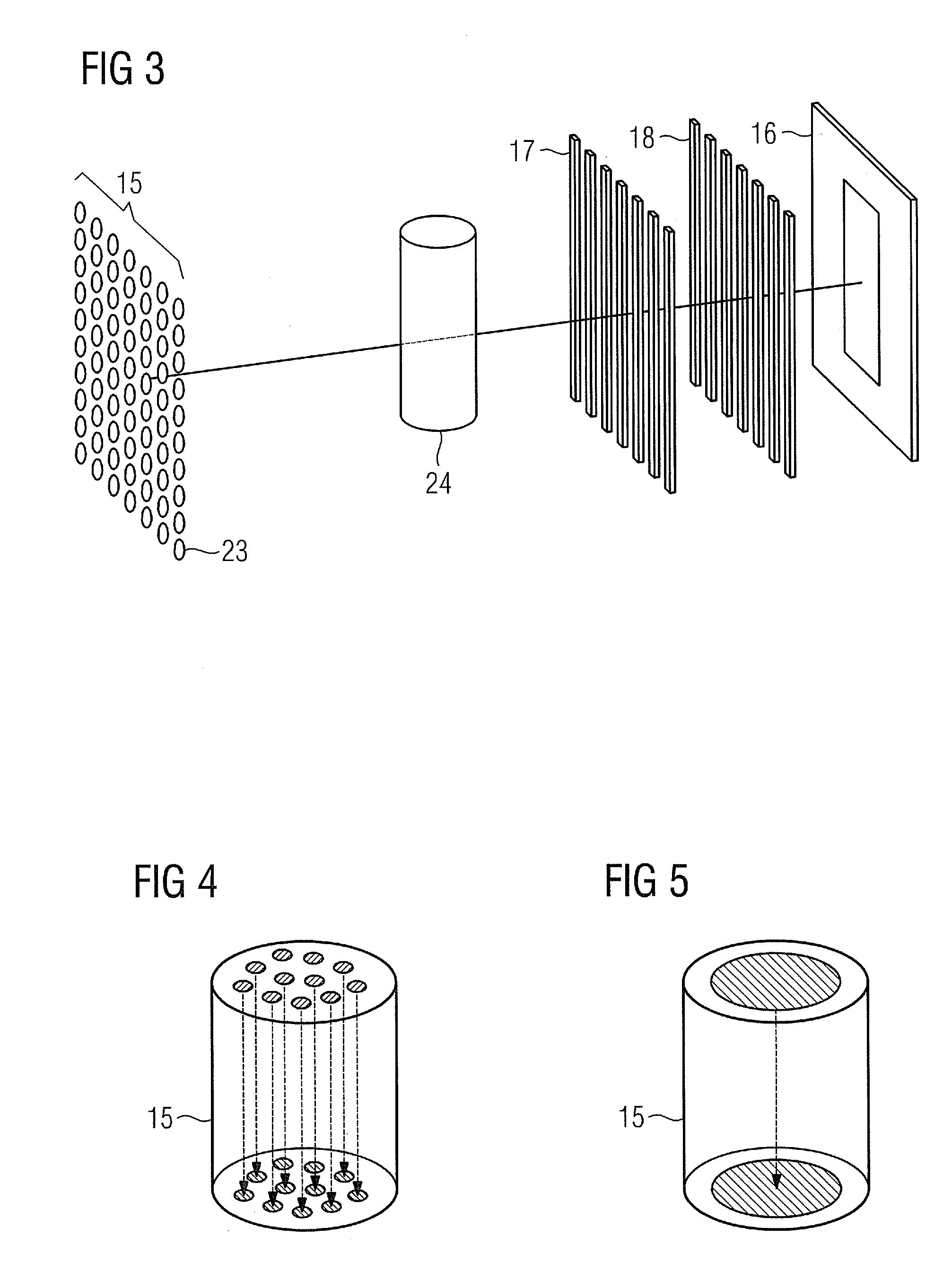[0005]It is the object of the present invention to provide an X-ray imaging system which not only enables
good image quality in respect of spatial resolution but also allows good
visualization of
soft tissue.
[0007]The biplane X-ray imaging system according to the invention has two recording units arranged in different planes, each such unit having an X-ray
detector and an X-ray source, wherein the first recording unit is formed by a phase-contrast recording unit for phase-contrast X-ray imaging. Phase-contrast X-ray imaging exploits the fact that different types of
body tissue diffract X-ray beams to different degrees. The phase shift effect when an X-ray beams passes through an examination subject is significantly stronger than the
absorption effect of the material penetrated by the X-
ray radiation. By means of phase-contrast X-ray imaging soft parts can be represented with particularly
high contrast in X-ray examinations. In combination with a second, conventional recording unit (which measures the X-
ray radiation attenuated through absorption in an examination subject) the biplane X-ray imaging system according to the invention can provide not only conventional projection images but also particularly high-quality visualizations of soft parts. This makes such a system also suitable for minimally invasive interventions and minimally surgical interventional procedures.
[0008]According to an embodiment of the invention the first recording unit embodied for phase-contrast X-ray imaging has an X-ray tube
assembly, an X-ray detector, a
phase grating which is disposed between an examination subject and the X-ray detector, and an amplitude
grating which is disposed between the
phase grating and the X-ray detector. In order to generate quasi-coherent X-
ray radiation, as is required for phase-contrast X-ray imaging, two alternatives can be used: According to a first alternative the first recording unit has a further
grating which is disposed behind the X-ray tube
assembly of the first recording unit and is embodied for the purpose of generating coherent X-ray
radiation from the non-coherent X-ray
radiation of the X-ray tube
assembly. According to a second alternative the X-ray tube assembly of the first recording unit has a plurality of field-emission X-ray sources for emitting quasi-coherent X-ray
radiation. Integrating an X-ray tube assembly having field-emission X-ray sources into a phase-contrast X-ray imaging system eliminates the need for the complex source
grating for generating monochromatic X-ray radiation, because the field-emission X-ray sources constitute a simple and effortless means of generating mutually coherent X-ray beams with a narrow focus. This enables the X-ray imaging system to be manufactured in a particularly compact design and particularly economically.
[0012]In the case of a field-emission X-ray source or, as the case may be, the corresponding field-emission
cathode, electrons are emitted as a result of a sufficiently high
electric field being applied. Field emission is achieved e.g. by means of a simple
diode mode in which a bias
voltage is applied between
anode and
cathode. Electrons are emitted by the
cathode when the
electric field exceeds the emission threshold. A
triode construction can also be provided in which a gate
electrode is disposed close to the cathode. Electrons are emitted here by applying a bias
voltage between gate and cathode. The emitted electrons are then accelerated by means of a
high voltage between gate and
anode. Field-emission cathodes a very high, readily controllable and easily focusable
electron beam current. All in all, by means of the field-emission X-ray sources the invention affords the advantages of low
heat generation by the field-emission X-ray tube assembly and a low weight, not only on account of the field-emission tube assembly itself but also as a result of the omission or reduction in size of a cooling system. Furthermore such a field-emission tube assembly is highly compact in comparison with conventional X-ray tube assemblies, thereby establishing the
precondition for providing a high-quality, laminar X-ray source having a surface area of many focal points arranged adjacent to one another. This is ensured in particular by means of an array having a plurality of field-emission tube assemblies. The useful life of field-emission tube assemblies is also significantly higher than that of known X-ray tube assemblies using thermal cathodes. In addition, by comparison with a thermal cathode a field-emission cathode can be started quickly without heating. Moreover, a higher spatial resolution can be achieved for X-ray images thanks to the readily focusable
electron current.
[0018]Both recording units beneficially have C-arms. The recording units are advantageously disposed on at least one
robotic arm, in particular a 6-axis articulated-arm
robot, in order to provide particularly good, quick and simple adjustability in three dimensions.
 Login to View More
Login to View More  Login to View More
Login to View More 


